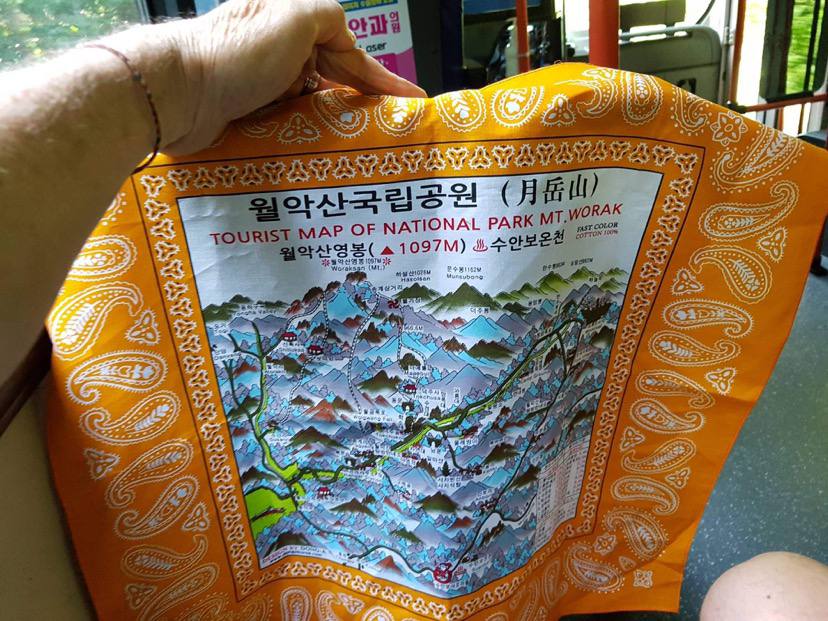Saturday morning, and no sooner had I stepped out of the subway train at Gangbyeon Station than this man accosted me. He noted that I was a foreigner and thus maybe an easy mark. Equally monolingual, he indicated that he was hungry and wanted me to alleviate the situation. I was not inclined to cooperate. As I went down the stairs, through the turnstiles and onto the sidewalk, he kept pestering me. I looked at him with some disdain and made comments like “So you want free money, do you?” and “Why don’t you give me free money?” and “Hell, no!” and “Forget it, buster.” Even before the light changed and I was able to cross the street to Dongseoul Bus Terminal, I saw Jimmy. That’s the name I give to a legless man who so frequently sits there asking for alms. Jimmy, who had some kind of recorded music going, is one of my favorites. I have made many donations to him over the years, and never do I fail to give at least 1,000 won. This time, it was 5,000. I assume—and hope—the bothersome fool saw it as I went on inside and purchased a ticket southeast to Chungju.
That was not my actual destination, as I had been there twice—in February 2013 and the next year at Konkuk University (Chungju campus) to gather signatures on petitions for the bring-Jikji-back-to-Korea campaign. The tourist office inside the bus terminal was operated by a lady who called herself Shiny. After determining that no bus went all the way to Woraksan National Park—highly recommended by my friends Hans Lee and Hwaseop Joo—she said that one did go to Suanbo and maybe I could make connections there for another into the park. I had been to Suanbo as well, soaking in one of the city’s famous hot springs. Shiny walked me to the bus stop and saw me off.
Half an hour later, I was there. Shiny’s counterpart was a somewhat older woman who wore a beautiful black dress. She spoke no more English than the begging guy back in Seoul, but she did her best to help. Soon she was on the phone with Shiny. Together, they learned that a bus would be coming through in an hour. That allowed me time to visit an air-conditioned restaurant across the street and consume a repast of cheonggukchang. As I did so, I watched a mixed badminton match between the Netherlands and Korea being played at the Tokyo Olympics. I noticed that most of an entire wall of the restaurant was devoted to messages of good will from its customers. The proprietor allowed me to post one of my own. I scrawled “Best sikdang in Suanbo,” signed it and attached my UT Longhorn card along with a photo of the map on the bathroom door at home showing the 250 or so places around Korea I have visited.
The bus was right on time, and everything looked copacetic. Once we entered Woraksan National Park, I had visions of climbing to the top of the enchanted and mysterious Worak Mountain; believers in the mountain-spirit Sansin offer prayers, incense, food and drink at an altar near its peak.
How many bus rides have I taken in Korea? The number is very large, but never before had I experienced a mechanical problem. This was the time, as we came to a sputtering halt. The driver, a worried expression on his face, got out and saw smoke emerging from near the engine. A call was made to send a replacement bus, and an hour later it arrived. I have to confess, the situation was by no means unpleasant. We were in the middle of a forest, and the bus was cool throughout our “ordeal.” A couple of older women did not look too happy, but two sets of teenagers (one all-male, the other all-female) laughed and cavorted while I read 20 pages of The History of Mankind by Hendrik Willem van Loon.
The further we went into the park, the more I saw that this place was quite popular. Both sides of the road were lined with the cars of vacationing Koreans. Dads, moms, kids and others were having a ball in the various creeks we passed. That water looked so good. I thought maybe I could play in it after ascending and descending the 1,094-meter-high mountain.
I got out and although the setting was no less than sublime, I had an uneasy feeling. Three times, four times I asked about lodging. In each case, I got a shake of the head or the familiar crossed hands meaning “no.” A decision had to be made quickly because the bus returning to Suanbo was coming soon and it might be the last one of the day. With the greatest reluctance, I had to admit I would not be spending the night there. I bought a bottle of cold water and two—one green, one orange—bandannas commemorating the fact that I have been to Woraksan National Park. I planned to give one to a friend and add the other to a large collection back home.
The bus came, and it was the same one with the same driver who had dropped me off 30 minutes before. For some reason, it did not stop in Suanbo but went directly to Chungju. That enabled me to see Shiny again and tell her my sad story.
It was 6 p.m. when I got back to Seoul, about eight hours after my departure in the morning. Coming up out of the subway, I saw a video advertisement that featured a handsome face I was familiar with. It belonged to the son of Lee Byeong-dal, who had created several of my bring-Jikji-home banners.
#travelsofanamericankorean #chungju #suanbo #worakmountain #woraksannationalpark #expatinkorea #hendrikwillemvanloon #brinkjikjibacktokorea #dongseoulbusterminal


Add Comment